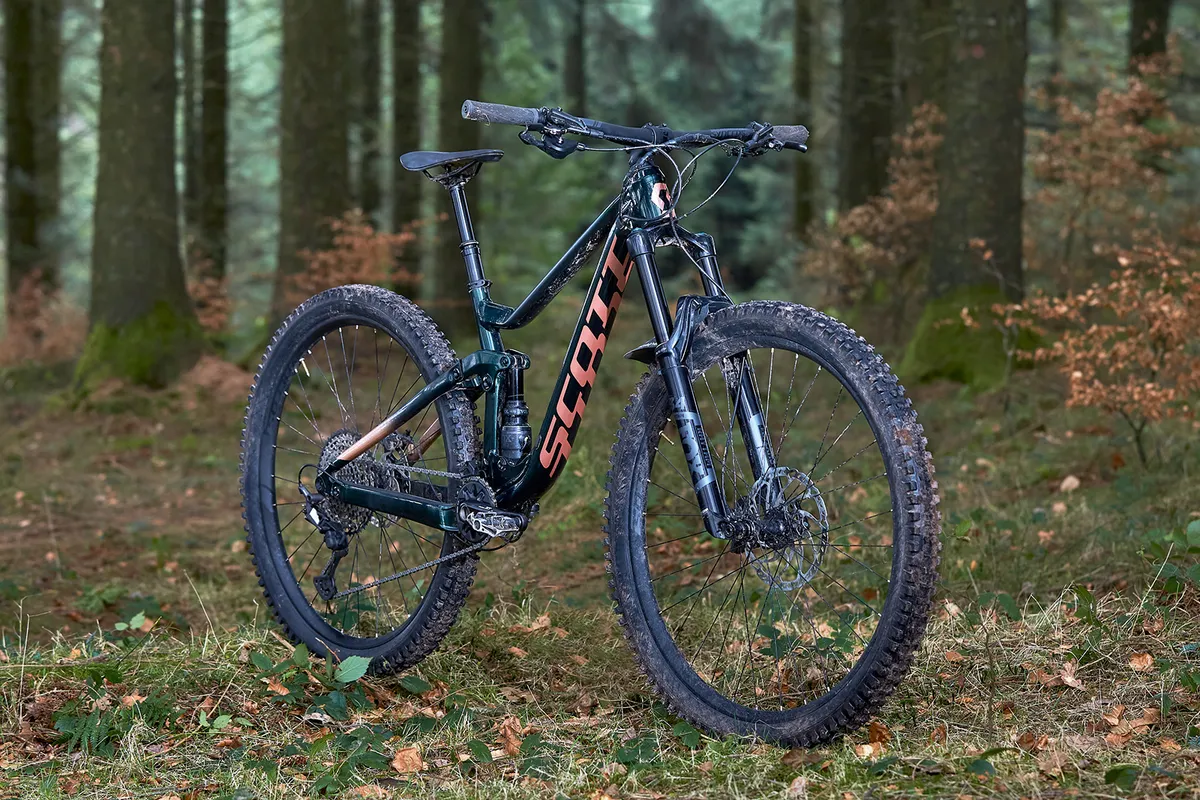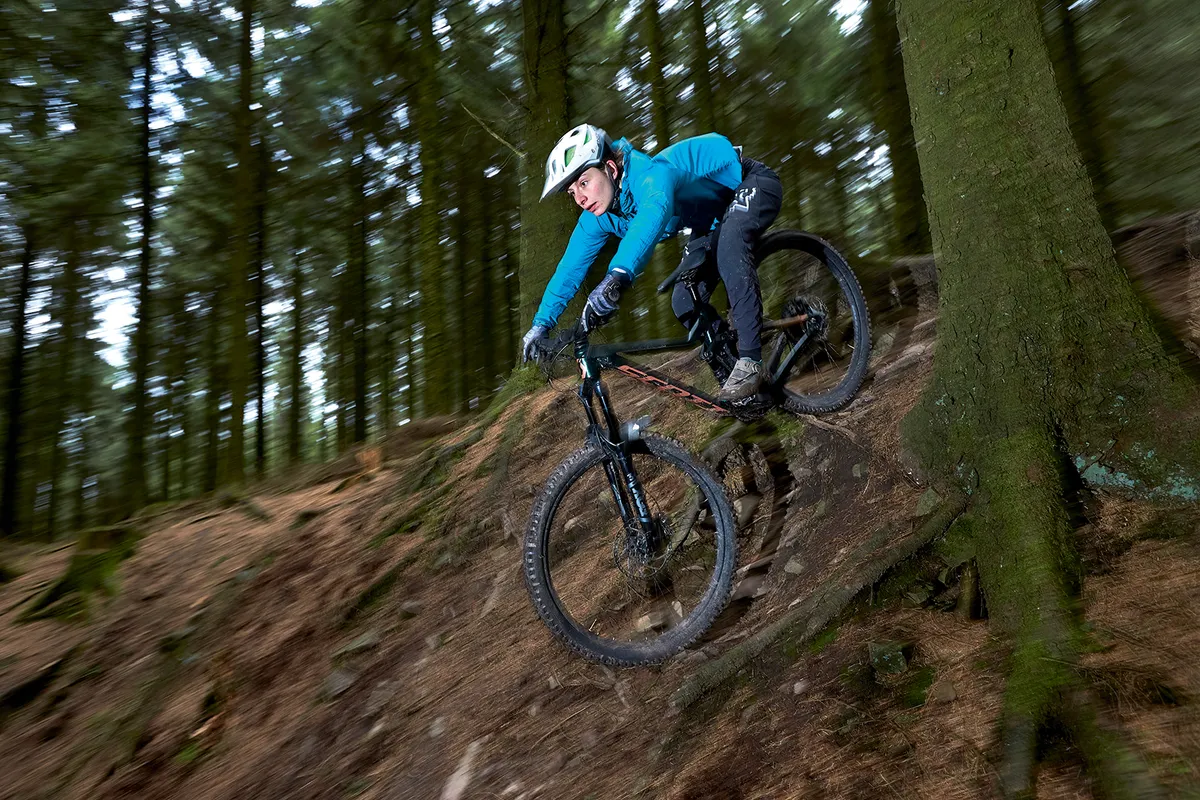Scott has kept the Contessa Genius’s frame the same as the unisex model, unlike the Canyon Spectral I also had on test.
The spec seems pretty modest for the price, although you do get some neat features which, paired with 29in wheels, make for an interesting bike.
Like its enduro-loving sister, the Contessa Ransom, you can retrofit it with 650b hoops. With this in mind, can the only bike on test with an alloy frame take on three carbon beasts: Canyon's Spectral WMN CF 8.0, Juliana's Maverick C R and Liv's Intrigue Advanced 1?
Scott Contessa Genius 910 frame
Scott sells through traditional shops, with all the benefits that entails. But with a distributor and retailer both taking a cut, you only get an alloy frame, for pretty much the same price as the mostly-carbon Canyon.
Although it’s heavier, good geometry compensates for the extra weight. Whether going up or down, the bike’s shape makes it feel capable in all situations.
Its 65-degree head angle is the slackest on test and, if you prefer to fit 650b wheels, you need only switch the flip-chip in the upper shock mount from ‘Low’ to ‘High’.
Unlike Canyon and Liv, Scott offers the same sizes (small, medium, large) as on its unisex bikes, making it easier for riders who enjoy fast, rough descents to size up for more reach.
I rode the small, because no medium was available. This was the size recommended by Scott’s website, but I found the short reach (405.9mm) made getting in the right position between the wheels a bit of a balancing act, and would have preferred the next size up.

Scott Contessa Genius 910 kit
There’s a bit of a rats’ nest of cables in front of the handlebar, due to Scott’s TwinLoc suspension adjustment system.
The actuator sits where you’d usually find the dropper post remote (there’s a vertical lever next to the grip for it instead) and lets you toggle the fork and shock between three modes simultaneously: ‘Descend’, ‘Traction Control’ and ‘Lockout’.
Each click changes the spring curve, firming up the suspension, effectively reducing the rear travel from 150mm to 100mm in the middle setting, and thus altering the geometry – keeping the head and seat angles steeper and the bottom bracket higher for easier climbing.
The Fox 34 Rhythm fork and proprietary Nude shock give a supportive platform. A lever on the shock body lets you toggle between linear or progressive settings in Descend mode.
While the Syncros (Scott’s in-house brand) dropper works well enough, its short 100mm stroke meant that when I had the saddle in a good position for pedalling, I couldn’t drop it far enough out of the way on descents.
The brakes are Shimano’s budget MT520s, but they’re no less powerful than the Juliana’s SRAM stoppers.

Scott Contessa Genius 910 ride impressions
My first ride on the Contessa Genius was tough. The low-profile Maxxis Rekon tyres aren’t suited to British winter riding and I found the limits of grip quickly.
For the next one, I fitted e*thirteen TRS+ tyres, which transformed the ride feel. With better rubber, the big wheels roll over bumps easily and the relaxed head angle is well-suited to descents.
The small size wasn’t quite big enough for me, but the medium’s long reach (440mm) would add stability on downhills. For a 29er, the Scott is easy enough to lean over in corners, but with its slower-accelerating wheels and heavier alloy frame, it’s more sluggish than the other bikes on test.
The suspension feels well-balanced and composed, especially with the shock left in its progressive setting. While the Rhythm fork is cheaper and heavier than the regular Fox 34, its GRIP damper works well. Its 34mm stanchions mean it’s prone to flex on tougher terrain though, limiting the descending potential of a bike that otherwise encourages you to hit rough tracks good and fast.
Also, I'm unsure why the equivalent unisex Genius (the 940) is upgraded to a slightly lighter Performance fork with the same damper.
While the TwinLoc system can be useful, I’d prefer to have fewer cables and levers. A simple shock lockout would do because the bike climbs well.
Scott Contessa Genius 910 geometry
- Seat angle: 74.7 degrees
- Head angle: 65 degrees
- Chainstay: 43.8cm / 17.2in
- Seat tube: 41cm / 16.1in
- Top tube: 54.2cm / 21.34in
- Head tube: 9.5cm / 3.7in
- Trail: 11.77cm / 4.6in
- Bottom bracket drop: 2.74cm / 1.1in
- Bottom bracket height: 35.2cm / 13.86in
- Wheelbase: 1,166mm / 45.9in
- Stack: 59.97cm / 23.6in
- Reach: 40.6cm / 16in
How we tested
Four popular female-focused trail bikes were put through their paces to see which performs best on the ups, downs and everything in between.
Brands take a varied approach to designing bikes for female riders, but in this test Scott designs its frames identically for both unisex and women’s bikes, Juliana’s measurements are the same as that of its brother company Santa Cruz, while Liv and Canyon modify their frame dimensions for female riders
Bikes also on test:
- Canyon Spectral WMN CF 8.0
- Juliana Maverick C R
- Liv Intrigue Advanced 1
Product
| Brand | Scott |
| Price | €3599.00, £3299.00, $3600.00 |
| Weight | 13.94kg |
Features
| Fork | Fox Rhythm 34 GRIP3 w/ TwinLoc, 150mm (5.9in) travel |
| Stem | Syncros FL2.0, 40mm |
| Chain | Shimano SLX M7100 |
| Frame | Butted 6011 aluminium alloy, 150/100mm (5.9/3.9in) travel |
| Tyres | Maxxis Rekon EXO TR 29x2.6in |
| Brakes | Shimano Deore MT520 |
| Cranks | Shimano Deore XT M8120, 30t |
| Saddle | Syncros Savona V-Concept 2.0 |
| Wheels | Syncros X-30S |
| Headset | Syncros Pro E2 |
| Shifter | Shimano SLX M7100 |
| Cassette | Shimano SLX M7100, 10-51t |
| Seatpost | Syncros Duncan 2.0 dropper |
| Grips/tape | Syncros |
| Handlebar | Syncros Hixon 2.0, 780mm |
| Rear shock | Fox Nude TR EVOL w/ TwinLoc |
| Bottom bracket | Shimano HollowTech II |
| Available sizes | S, M, L |
| Rear derailleur | Shimano Deore XT M8100 (1x12) |
| Features | Hubs: Formula ST-1905 (f) / Formula MST-148 (r) Axles: 15x110mm Boost (f) / 12x148mm Boost (r) Spokes: Stainless steel Wheel weight: 2.39kg (f), 3.08kg (r), inc. tyres |